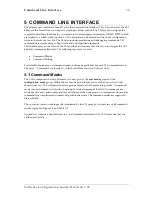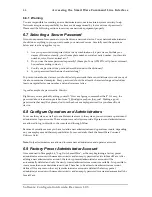
Command Line Interface
37
from configure mode
source
source {class¦policy} <name>
command from profile_service-policy
mode
node
(src) [<name>]#
profile_voip
profile voip <name>
command from
configure mode
node
(pf-voip) [<name>]#
profile_tone-set
profile tone-set <name>
command
from configure mode
node
(pf-tones) [<name>]#
profile_call-progress-
tone
profile call-progress-tone
command
from configure mode
node
(pf-callp) [<name>]#
Table 5-1: Command Mode Entry and Prompts
5.2 Command Editing
5.2.1 Command Help
To see a list of all CLI commands available within a mode, type a question mark “
?
” at the system
prompt in the mode of interest. A list of all available commands is displayed. Commands that have
become available in the current mode are displayed at the bottom of the list, separated by a line.
Commands from higher hierarchy levels are listed at the top.
You can also type the question mark while in the middle of entering a command. Doing so displays
the list of allowed choices for the current keyword in the command. Liberal use of the question mark
functionality is an easy and effective way to explore the command syntax.
5.2.2 The No Form
Almost every command supports the keyword
no
. Typing the
no
keyword in front of a command
disables the function or “deletes” a command from the configuration. For example, to enable the
Session Router trace tool, enter the command
debug session-router
. To subsequently disable the
Session Router trace, enter the command
no debug session-router
.
5.2.3 Command Completion
You can use the Tab key in any mode to carry out command completion. Partially typing a command
name and pressing the Tab key causes the command to be displayed in full up to the point where a
further choice has to be made. For example, rather than typing
configur
e, typing
conf
and Tab
causes the CLI to complete the command at the prompt. If the number of characters is not sufficient
to uniquely identify the command, the CLI will provide a list with all commands starting with the
typed characters. For example if you entered the string
co
in the configure mode and press Tab, the
selection
configure
,
copy
and
context
is displayed.
5.2.4 Command History
SmartWare maintains a list of previously entered commands that you can step through by pressing
the
<up-arrow>
and
<down-arrow>
keys, and then pressing
<enter>
to enter the command.
The
show history
command displays a list of the commands you can step through using the arrow
keys.
5.2.5 Command Editing Shortcuts
The SmartWare CLI provides a number of Emacs-style command shortcuts that facilitate editing of
the command line. Table 5-2 summarized the available command editing shortcuts. The syntax
Ctrl-
p
means press the
p
key while holding down the keyboard’s “Control” key (sometimes labeled
Ctl
or
Ctrl
, depending on the keyboard and operating system of your computer).
Software Configuration Guide, Revision 1.03
















































